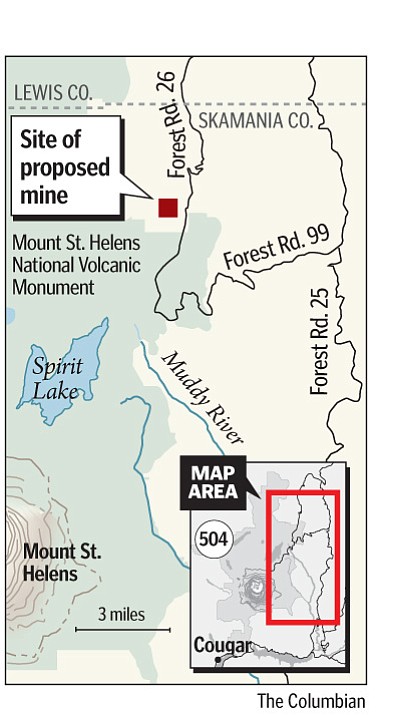A national environmental group has named a proposed copper mine 10 miles north of Mount St. Helens National Volcanic Monument as one of 10 projects that put prospecting ahead of other activities on even the nation’s most revered public lands.
The Pew Charitable Trusts’ “Ten Treasures at Risk” report identifies Mount St. Helens along with the Grand Canyon and Yosemite national parks and Mount Rushmore National Monument as special areas at risk from the provisions of the 1872 Mining Law.
The law, a legacy of 19th-century western expansion, gives mining companies free and open access to nearly 350 million acres of public lands. It allows mining companies, including those that are foreign-owned, to patent proven claims, converting subsurface rights to private ownership, and to take about $1 billion annually in high-value minerals from public lands without paying a royalty.
Congress has repeatedly and unsuccessfully tried to modernize the law, Pew said in unveiling its list, “but until the law is brought up to date, few good options exist for protecting such places as the Grand Canyon from hard-rock mining.”
Pew said nearly 60 claims have been staked north of Mount St. Helens, most of them in 2004. Some are near the Green River and in national forest roadless areas; others are near holdings mining companies acquired from the federal government under the 1872 law.
“Plans for a massive copper mine in the area were put on hold after a public outcry in 2008, but new interest in the area by Canadian-based mining companies could result in large-scale mining on the edge of the monument boundary,” Pew said.
Last year, Canadian company Ascot Resources Ltd. began exploratory drilling at the site north of the volcano. It has applied to drill 30 additional holes this summer.
The area, which contains copper, gold and molybdenum deposits, has long been a center of mining activity.
“When the boundaries of Mount St. Helens Monument were created, Congress was well aware of the historical mining and purposely excluded this area,” said Ron Freeman, public services staff officer for the Gifford Pinchot National Forest.
Rick Kasum, operations manager for Vancouver, B.C.-based Ascot Resources, expressed disbelief that anyone would object to mining in the area, which was squarely in the blast zone of the 1980 eruption.
“How can that be?” he said. “You’re in a devastated area already. Mount St. Helens is like a bomb went off. It’s all been clear-cut. We’re in an industrially zoned area. There’s a rock quarry and a lot of private land has been clear-cut, too. We are utilizing old logging roads. We’re not making new roads. Our impact is zero.”
If mineral deposits valuable enough to be profitable are proved, it could still be at least a decade before the company satisfies environmental requirements and begins mining, Freeman said.
“They are probably 10 to 20 years from any kind of a mine proposal,” he said. “You have to make a case that it is economically viable. Then they would go through a massive environmental impact statement. There will be impacts, and we will work with them.”
Kasum noted that the company already holds a patented claim to the main copper deposit.
“We could go and drill, but we want to work with the government on it,” he said. “We’ve been 100 percent environmentally sound. We want to do everything right.”
The mining claims in question have a complicated history. They were explored in the 1970s and early 1980s by the Duvall Corp., which drilled more than 200 exploratory holes. Idaho General Mines of Spokane later acquired them, but that company in turn was purchased by Colorado-based General Moly, which applied to lease 217 acres of national forest land for hard-rock mining on the south-facing slope of Goat Mountain, a 5,400-foot promontory.
In 2008, the BLM rejected General Moly’s lease application, saying the agency wasn’t able to determine whether a hard-rock mining lease would be compatible with the purpose for which the lands were purchased. The Forest Service had bought a portion of the lands from the nonprofit Trust for Public Land in 1986, six years after the eruption of Mount St. Helens, using Land and Water Conservation dollars from offshore oil and gas leases.
“One of the reasons BLM denied the lease was because they wanted more information to prove the validity of the deposit,” Freeman said. “This company has taken a different approach. They did not apply for a lease. They drilled 14 holes last summer and another 30 are planned this summer. They are working with us. We are working together.”
Ownership of the ore deposits is equally complicated. Ascot Resources holds a private right to half the subsurface copper ore deposit; the Forest Service owns the other 50 percent. The surface rights belong to the Forest Service.
However, Ascot recently applied to the BLM for a prospecting permit to begin exploratory drilling on national forest land outside the ore deposit the company owns. That, Freeman said, will require a separate environmental assessment.
Kathie Durbin: 360-735-4523 or kathie.durbin@columbian.com.



